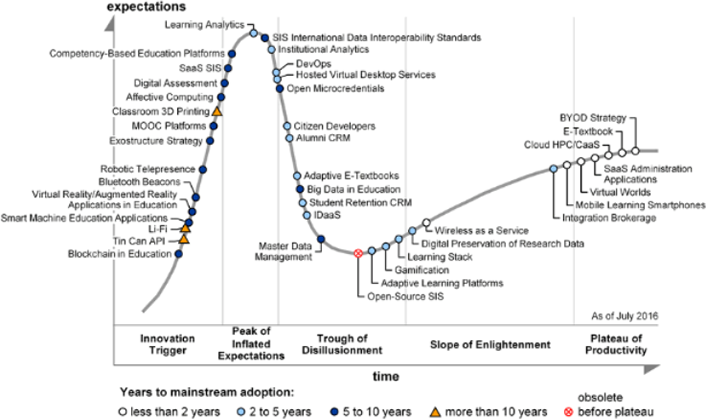Every year Gartner publishes its Hype Cycle of Education. For 2016, we have invited members of CHEIA to post their reflections on this hype cycle for Christian Higher Education. Here they are:
Andrew Sears
- I’m not surprised that learning analytics wins the award for the most hyped technology this year.
- I’m a bit surprised the list “MOOC Platforms” as still going up the curve, but I’m guessing they are referring to things like Open EdX rather than MOOCs themselves.
- I hadn’t heard of the Tin Can API (which is basically a programming standard for communicating learning), but it sounds interesting.
- The term Exostructure Strategy is new, but it basically seems like an overarching architectural strategy for using cloud-based educational infrastructure, which seems promising.
- I would agree that we are just starting to see the potential of VR/AR and blockchain in education.
- This website has another hype cycle graph that looks like its from last year, but it has very helpful definitions for all the items.
- I think there are a lot of things missing such as: micro credentials/degrees, many global innovations, microcampuses, adaptive learning, etc.
What should CHE Learn from the Gartner Hype Cycle? In diffusion of innovation theory, innovators are the first 2.5% of people to adopt a new technology. That is part of our role-to determine whether a new technology might eventually be promising.
Unfortunately many of us innovators have a bit of ADD and are always focused on the next new shiny thing. So we play with things on the first half of the graph, and then then dump them forever like a bad date once they hit the trough of disillusionment. The result is that our organizations and the innovations we test, rarely “cross the chasm” into mainstream use . I think our success as innovators should me measured not by how many shiny things we identify, but by how many innovations we help bring into mainstream adoption in our organizations in a way that is transformative. Ultimately as Christians we are under the collective mission statement of “love God, love others,” so as we evaluate technologies to consider whether to take them into mainstream, we should always ask how this technology will help us love God or love others better.
Matthew Henry
- Hard to sift through technology, philosophical and pedagogical pieces. I think this is critical as teaching and learning from an innovation perspective continues to break down walls to what we considered in the past to be nice neat silos. Technology like autonomous vehicles merges computer science, mechanical engineering, physics and math. This is critical for CHE in several aspects:
- Our degree programs cannot be one field anymore
- Our bents, whether dystopian or utopian must separate Biblical and theological understanding from our current cultural understanding whether that be American culture or another country. This is not unlike what first century Christians dealt with when Jesus was Lord versus Ceaser. Seat time, lectures, and more are not necessarily the end all of education.
- Similar to the early 1900’s movement of electric power generation that HE set up and maintained on their campuses that moved to grids outside of organization, the cloud will become the leading driver. Microsoft released a recent A Cloud for Global Good that details both what is happening and many of the unknowns. Reading this hype cycle, cloud is the base of what’s happening. For CHE, similar to the above we philosophically need to define a Biblical understanding of the cloud. Concerns over privacy, government control, partnership with non-Christians need to be addressed.
- Exostructure Strategy is a critical to the cloud working. New startups like http://www.n2nintegration.com/bringing this exostructure to education are critical. As technologist in CHE, we must embrace and see our IT departments transform to be at the center of both a new economy (cost savings) and new structures (innovation).
- Underlying many of the innovations is AI. However, some of the specifics like bots are missing. A signal of how powerful this is can be seen with duolingo.com’s recent announcement of Bots: http://bots.duolingo.com/. While Duolingo’s bots are incredible (you need to try them, they remember your favorite color, your name, etc.), you get a glimpse of what a teaching and learning world would look like where the teaching and learning is done by AI programs. Humans become mentors and coaches.
- Competency-based hiring. While not specifically a technology, the technologies that are now available (http://www.forbes.com/sites/ryancraig/2016/10/01/competency-based-hiring-10-signals-the-shift-is-happening/) will impact education in ways we can’t imagine.
Evan Donovan
